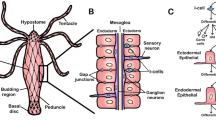Summary
The zymogenic secretory cells of Hydra viridis are scattered between the digestive muscle cells of the gastric region. The mature zymogenic cells are located along the apical surface of the gastrodermal epithelium and contain numerous spherical secretory droplets. They appear to differentiate from stem cells located near the mesoglea. These stem cells resemble epidermal interstitial cells and are filled with free ribosomes. They differ from the interstitial cell in that they usually possess a small amount of granular endoplasmic reticulum. During the process of differentiation they elaborate a highly organized system of granular endoplasmic reticulum. This system becomes dispersed into vesicles as the secretory product is synthesized. There is no indication that the Golgi apparatus participates directly in the formation of the secretory droplets, and there is no indication of a membrane bounding the mature secretory droplet.
The fate of the zymogenic cell following the discharge of its secretory product was not determined. It is possible that these cells revert back to a stage resembling the stem cell before resynthesizing a new supply of secretion. In this case the normal secretory process would be very similar to the events described in the dedifferentiation of the zymogenic cells during regeneration.
Similar content being viewed by others
References
Bouillon, J.: Les cellules glandulaires des hydroides et hydroméduses. Leur structure et la nature de leurs sécrétions. Cah. Biol. Mar. 7, 157–205 (1966).
Brien, P., et M. Reniers-Decoen: La signification des cellules interstitielles des hydres d'eau douce et le problème de la réserve embryonaire. Bull. biol. France et Belg. 89, 258–325 (1955).
Brock, M. A., B. L. Strehler, and D. Brandes: Ultrastructural studies on the life cycle of a short-lived metazoan, Campanularia flexuosa. I. Structure of the young adult. J. Ultrastruct. Res. 21, 281–312 (1968).
Burnett, A. L.: Histophysiology of growth in Hydra. J. exp. Zool. 140, 281–342 (1959).
—: A model of growth and cell differentiation in Hydra. Amer. Naturalist 100, 165–189 (1966).
Davis, L. E., A. L. Burnett, J. F. Haynes, and V. Mumaw: A histological and ultrastructural study of dedifferentiation and redifferentiation of digestive and gland cells in Hydra viridis. Develop. Biol. 14, 307–329 (1966).
Gauthier, G. F.: Cytological studies on the gastroderm of Hydra. J. exp. Zool. 152, 13–39 (1963).
Haynes, J. F., and A. L. Burnett: Dedifferenatiation and redifferentiation of cells in Hydra viridis. Science 142, 1481–1483 (1963).
Hess, A.: The fine structure of cells in Hydra. In: The biology of hydra and some other coelenterates (H. M. Lenhoff and W. F. Loomis, eds.), p. 1–49. Coral Gables, Fla.: Miami University Press 1961.
Lenhoff, H. M.: Digestion of protein in Hydra as studied using radioautography and fractionation by differential solubilities. Exp. Cell Res. 23, 335–353 (1961).
Lentz, Thomas L.: The fine structure of the differentiating interstitial cells in Hydra. Z. Zellforsch. 67, 547–560 (1965).
Loomis, W. F., and H. Lenhoff: Growth and sexual differentiation of Hydra in mass culture. J. exp. Zool. 132, 555–574 (1956).
Reynolds, E. S.: The use of lead citrate at high pH as an electron-opaque stain in electron microscopy. J. Cell Biol. 17, 208–212 (1963).
Rose, P., and A. L. Burnett: An electron microscopic and histochemical study of the secretory cells in Hydra viridis. Wilhelm Roux'Archiv 161, 281–297 (1968a).
—: An electron microscopic and radioautographic study of hypostomal regeneration in Hydra viridis. Wilhelm Roux'Archiv 161, 298–318 (1968b).
Semal-Van Gansen, P.: Etude d'une espèce Hydra attenuata Pallas. L'histophysiologie de l'endoderme de l'hydre d'eau douce. Ann. Soc. zool. Belg. 85, 187–278 (1954).
Slautterback, D. B., and D. W. Fawcett: The development of the cnidoblasts of hydra. An electron microscope study of cell differentiation. J. biophys. biochem. Cytol. 5, 441–452 (1959).
Watson, M. L.: Staining of tissue sections for electron microscopy with heavy metals. J. biophys. biochem. Cytol. 4, 475–478 (1958).
Author information
Authors and Affiliations
Additional information
This work was supported by Grant number GB-3262 from the National science Foundation.
Rights and permissions
About this article
Cite this article
Haynes, J.F., Davis, L.E. The ultrastructure of the zymogen cells in Hydra viridis . Z. Zellforsch. 100, 316–324 (1969). https://doi.org/10.1007/BF00343886
Received:
Issue Date:
DOI: https://doi.org/10.1007/BF00343886




